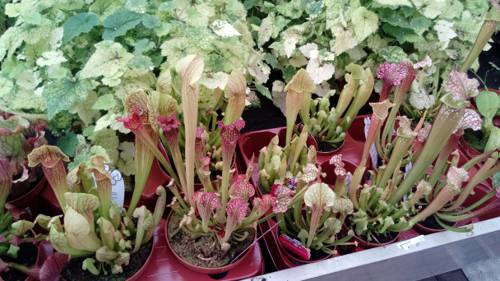
FAQ About Cultivating Indoor Exotic Carnivorous Plants

What are the main types of indoor exotic carnivorous plants?
Some of the most popular types of indoor exotic carnivorous plants include the Venus flytrap (Dionaea muscipula), pitcher plants (from the Nepenthaceae family), sundews (Drosera), and butterworts (Pinguicula). Each of these has unique adaptations for capturing and digesting insects and can add a fascinating element to your indoor garden.

What kind of soil do carnivorous plants prefer?
Carnivorous plants generally require a nutrient-poor, acidic soil. A common mix includes sphagnum peat moss and sand or perlite in equal parts. This mimics the natural bog environments these plants thrive in. Avoid using regular potting soil as it can be too rich in nutrients and can harm the plants.

How much sunlight do carnivorous plants need indoors?
Carnivorous plants typically require bright light to thrive indoors. For most species like the Venus flytrap and sundews, a south-facing windowsill or a place with 12-15 hours of fluorescent light daily is ideal. Lack of sufficient light can lead to weak growth and poor trap function.

How often should I water indoor carnivorous plants?
Carnivorous plants generally prefer consistently moist to wet soil. Water them with distilled, rain, or reverse osmosis water, as tap water can contain minerals that accumulate and harm the plants. Keep the soil damp, but avoid waterlogging, as excessive standing water may lead to root rot.

Can I feed my carnivorous plants insects?
Yes, feeding carnivorous plants small insects is beneficial, especially if the plants do not naturally capture enough on their own indoors. Live insects such as flies, small crickets, or mealworms are ideal. Feed them only once every few weeks and avoid overfeeding, which can cause stress or decay.

What temperatures are ideal for indoor carnivorous plants?
Most indoor carnivorous plants prefer a temperature range of 60-85°F (15-29°C). Venus flytraps and sundews can tolerate cooler temperatures down to 50°F (10°C) at night, but extreme fluctuations or prolonged cold spells should be avoided to prevent stress.

How do I fertilize carnivorous plants?
In general, carnivorous plants do not need regular fertilization if they are catching insects. However, if necessary, a highly diluted orchid fertilizer can be used sparingly. Applying liquid fertilizer to the soil or leaves is recommended, typically at one-quarter strength, every few months.

Do carnivorous plants need dormancy periods?
Many carnivorous plants, such as the Venus flytrap and some sundews, require a dormancy period during the winter months. This involves cooler temperatures and reduced water and light to mimic winter conditions. Dormancy is vital for their health and longevity, allowing them to rest and conserve energy.

Can I grow carnivorous plants from seeds indoors?
Yes, growing carnivorous plants from seeds is possible but requires patience. Seeds should be sown on a suitable soil mix kept constantly moist with high humidity levels. Germination can take several weeks to months, depending on the species. Providing consistent light and warmth enhances success rates.

How do I repot carnivorous plants?
Repotting carnivorous plants is advisable every 1-2 years to refresh the soil and accommodate growth. Gently remove the plant from its pot, trim any dead roots, and place it in a new pot with fresh carnivorous plant soil. Water the plant thoroughly after repotting to help reduce transplant shock.

Are there any pests that affect carnivorous plants?
Common pests such as aphids, spider mites, and mealybugs can occasionally infest carnivorous plants, even indoors. Regularly inspecting the plants and using appropriate non-toxic pest control measures, like insecticidal soap or manual removal, can help keep your plants healthy.

How can I ensure high humidity for indoor carnivorous plants?
To maintain high humidity for carnivorous plants, you can place a humidity tray filled with water near the plant, mist regularly, or use a room humidifier. Enclosing the plants in a terrarium or using a humidity dome can also provide a consistently moist environment, particularly beneficial for tropical species.

Can carnivorous plants survive without catching insects?
While carnivorous plants can survive for periods without catching insects, their growth may become slower, and trap development can be less robust over time. Feeding them occasionally helps keep them healthy if they are not naturally capturing prey in an indoor setting.

How do I prune carnivorous plants?
Pruning carnivorous plants involves removing dead or dying leaves and traps to encourage new growth and maintain plant health. Use sterilized scissors to cut off the brown or black portions as close to the base as possible, and always perform this task with care to avoid harming healthy parts of the plant.

What size pot should I use for carnivorous plants?
The pot size for carnivorous plants depends on the plant's size and species. Generally, a pot that allows for 2-3 inches of soil surrounding the root mass is sufficient. Using plastic or glazed ceramic pots can help keep the soil moist, whereas terra-cotta pots may dry out too quickly.

Can I use artificial light for carnivorous plants?
Yes, artificial lights such as fluorescent tubes or LED grow lights can be successfully used to cultivate carnivorous plants indoors. Ensure the light is positioned close enough to the plants (usually 4-6 inches away) to provide adequate intensity, ideally for 12-15 hours daily.

Are Venus flytraps safe for pets?
Yes, Venus flytraps are generally considered non-toxic to pets. However, it is advisable to keep them out of reach to prevent pets from nibbling on them, which can damage the plant. While not harmful, the traps are delicate and can be adversely affected by external interference.

What is the lifespan of a carnivorous plant?
The lifespan of a carnivorous plant varies by species and care conditions. Some species, like the Venus flytrap, can live 20 years or more with proper care, while others may have shorter or longer lifespans. Regular maintenance, a suitable environment, and appropriate feeding support longevity.

What are the signs of distress in carnivorous plants?
Signs of distress in carnivorous plants include discolored leaves or traps, mold growth, and stunted growth. Wilting, unusual softening, or odor can also indicate problems. Ensure correct light, water, and environmental conditions to help the plant recover from or prevent distress.

Where can I buy exotic carnivorous plants?
Exotic carnivorous plants can be purchased from specialized online nurseries, garden centers, and plant specialty stores. Check for reputable sellers who provide detailed care instructions and ship plants safely to preserve their condition upon arrival.
